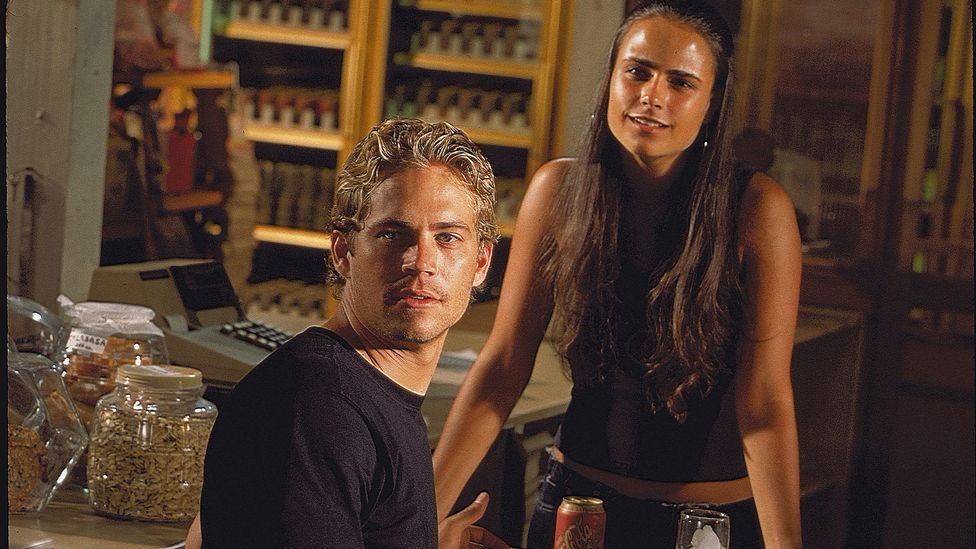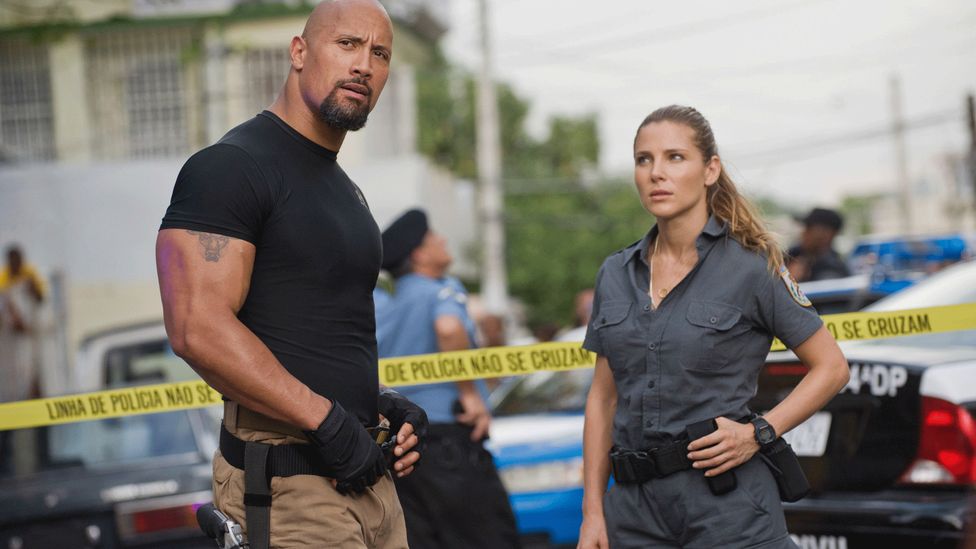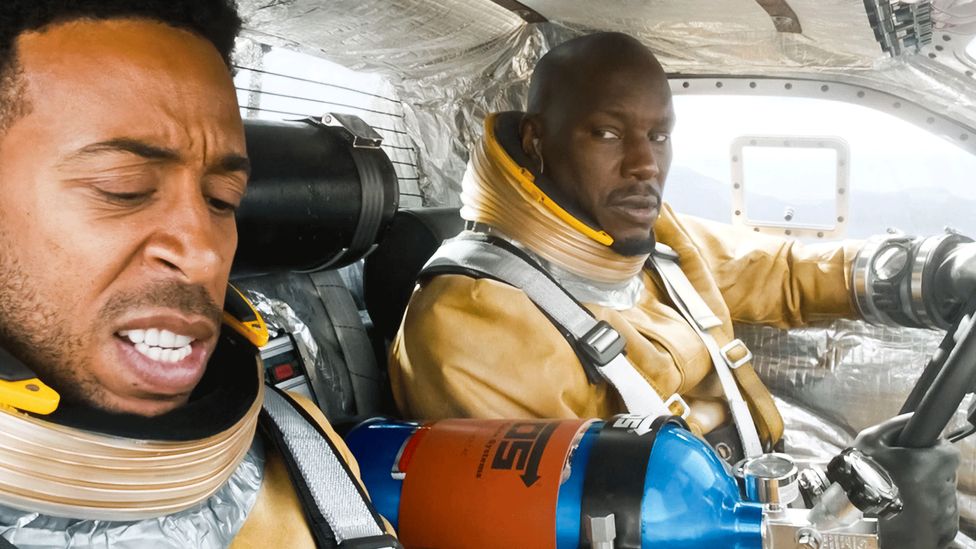In 2001's The Fast and the Furious, the hyper-macho gearhead Dominic Toretto (Vin Diesel) first uttered his now immortal motto that he lived his life "a quarter mile at a time", referring to how he lived from car race to car race. Twenty years, nine films, and several thousand miles later, as other series have come and gone, the Fast and Furious franchise has only increased in intensity and scale – and sheer ridiculousness – to the point where that phrase feels like an embodiment of its gung-ho willingness to try anything. What's more, as it has consistently transformed itself, it has reflected the way in which blockbuster filmmaking has shifted and evolved in the 21st Century.
More like this:
– Ten films to watch this June
– Is Tom Hanks the last great movie star?
– Why we no longer need superheroes
This week sees the US and UK release of the latest film, F9: The Fast Saga, which perhaps represents the apex of the series' newfound expansiveness, after it "evolved to more easily integrate itself into a post-Marvel world", as film critic Willow Maclay tells BBC Culture. The subtitle implies as much, its use of the word "saga" imbuing the series with a sense of grandeur that it wasn't really interested in when it began.

The first film was a Point Break-style drama about an undercover cop (Paul Walker) and some street racers that looks hilariously humble in retrospect (Credit: Alamy)
In hindsight, the roots of the long-running series look hilariously humble. The first film was conceived out of director Rob Cohen's reading of a 1998 article in US magazine Vibe detailing New York City's illegal street racing circuit. The Fast and the Furious is a fun Point Break-style drama, replacing surfing with street racing, about undercover Los Angeles cop Brian O'Connor (Paul Walker) falling in love with the lifestyle of a gang of racers, led by Diesel's Toretto, while on their tail for a string of truck robberies. But while in later films we see the racers stealing entire bank vaults, in this case their haul is… combination TV and DVD players.
The relative modesty of The Fast and the Furious as a blockbuster reflected the different tenor of Hollywood studio filmmaking at the beginning of the millennium. Back then, in 2001, studios put a lot more stock in mid-budget action and heist movies – think Ocean's 11, A Knight's Tale and Training Day, to pick a few popular contemporaries. These were films that relied on real, tangible action instead of visual effects and weren't invested in what we now call "universe building" – teeing themselves up for a web of future sequels and potential crossovers. At the same time, with the new Harry Potter and Lord of the Rings franchises kicking off that year, and the first X-Men film being released the year before, major change within the Hollywood ecosystem was on the horizon.
How the films have evolved
Since then, the series has proved surprisingly chameleonic, while going toe-to-toe with ever bigger hitters, financially speaking anyway. Its willingness to rip up the rulebook can be seen from the second instalment in the franchise, 2003's 2 Fast 2 Furious, which relocates the action to Florida and deviates from the world of the previous film almost entirely, except for holding onto Walker's O'Connor, who is no longer a cop and is now a bona-fide street-racing miscreant. It is a film often cited as the franchise's low point. Yet in fact it is quite the opposite, as the critic Katie Walsh pointed out in a recent piece for GQ magazine, praising, among other things its Miami Vice sheen and spaghetti western references. Directed by the late John Singleton, best known for 1991's seminal Boyz N the Hood, it also set the series apart early on as one with a racially diverse cast and crew. As a white man, Walker's character was on the outside looking in – something that still sadly feels like a rarity amongst bigger budget films. Then, the third instalment, 2006's The Fast and the Furious: Tokyo Drift, directed by Justin Lin, shook things up yet again. Heavily inspired by the manga series Initial D, Lin's debut in the franchise explored drift racing, a style that involves intentional oversteering and sliding around corners, and took the film to its birthplace of Japan.
These early entries were mostly about one thing: the cars. They set out to convey the allure of street racing via the lavishness of their equipment. What was most breathtaking about them were the details of their characters' often ludicrous vehicles, and the technical specificity with which they talked about them (the later films are a lot more straightforward). Giant rear spoilers and nitro boosts were commonplace, while 2 Fast 2 Furious gloriously matched up its performers' costumes with their customised cars, and Tokyo Drift had the outstanding sight gag of an Incredible Hulk Volkswagen, featuring the big green beast painted on its bodywork.
However, as the 2000s went on, the series continued shifting gears to accommodate changing audience tastes, and compete with new blockbuster rivals. In 2008, the first Marvel movie, Iron Man, was released, and so began a new age of superhero movies defined by two things: their computer-generated effects and their intricate intermingling of characters and plotlines within a "shared universe". At the same time, though, the Fast and Furious franchise was evolving in parallel. Indeed, 2009's Fast & Furious, the fourth film in the series and Lin's second as director, brought together disparate characters from different instalments, three years before The Avengers did a similar thing with Marvel superheroes. It was also unfortunately, an ugly and self-serious mess, though it at least laid the groundwork for Lin's 2011 follow-up Fast Five, a turning point for the franchise – and the moment when its current mega-popularity began to flourish.

Fast Five was a turning point for the franchise, upping the stakes and introducing another big personality in the form of The Rock (Credit: Alamy)
This fifth film took things in a strikingly different direction. As Toretto and O'Connor assembled a crew of their old friends from Fast 1 through 4, and planned an impossible heist, it shifted the series' focus away from street-racing vendettas and onto more high-stakes action, that subsequently came to incorporate international espionage (a move not always for the better). It also introduced another big personality to the mix in the form of Dwayne "The Rock" Johnson, playing government agent Luke Hobbs. His fights with fellow gigantic bald-headed man Vin Diesel were as entertaining as they were visually absurd, with them crashing through walls as they clashed heads.
As the series has progressed, through 2013's Fast and Furious 6, 2015's Furious 7, and 2017's The Fate of the Furious, the cars themselves have become less and less of the selling point: Toretto and his crew still have their pick of a wealth of underground souped-up motors, but if anything they are (slightly) more stripped back, and sometimes even military-looking, in their appearance. The sense of excess previously provided by the vehicles is now found in its excessive action, and equally excessive narrative, which bears the melodramatic influence of soap operas, complete with various shock appearances and narrative twists. The latest of those, in F9, are the appearance of John Cena as (inexplicably) Toretto's long-lost brother, and the resurrection of thought-to-be-long-dead fan favourite Han (Sung Kang).
With its increasingly complex history of feuds, heel turns and redemption arcs, Fast and Furious also shares an overwrought dramatic quality with TV wrestling. The series has an increasingly strong metatextual relationship with WWE figures in particular, thanks to the casting of personalities like The Rock, Roman Reigns and most recently Cena, playing with their personas and even adding their finishing moves to fight scenes that are completely over the top – and only outdone by the impossible (and frequently CGI) car stunts. In Furious 7, cars parachute from planes, and jump between not one but two skyscrapers. As for F9? Jokes have been made for years about the franchise being locked in a space race with Mission Impossible, to see who would put their characters there first. Well now, without giving too much away, one series has clinched it.
What sets the franchise apart
Still, for all its souped-up features, the question still remains: what has made the franchise quite so successful in a way that no one would surely have imagined 20 years ago? It's not simply the action. Perhaps it's because it has kept hold of one constant: a genuine, down-to-earth humanity that separates it from its contemporaries – including even its most obvious peer, the Mission Impossible series. While it's not exactly known for a depth of character, even as it gets bigger and bigger, it somehow doesn't feel more calculated – and that's in large part thanks to the emotional earnestness of its characters, both individually and as a de-facto "family". "Family" is a concept frequently cited by Fast and Furious characters, though in the context of the films it means a very loosely-defined unit, with Diesel's Toretto in the centre as the patriarch. As film critic Maclay points out, "[Toretto] believes anyone could be family". But that focus on family by bond rather than by blood is inviting, providing the films with a surprising sweetness.
That sweetness was also a key asset of Walker's fairly unremarkable leading man. An odd one out among the super-hackers and men so large they appear superhuman, O'Connor simply wanted to help out and keep his family safe. As Polygon's Joshua Rivera wrote recently, he was "just a guy who drove really well, and who wanted a normal life. The rest of the gang are mostly characterised by skill sets that draw them to dangerous careers". That everyman quality was made a joke of in a sequence in Furious 7, Walker's final film, in which some of the typical, tension-building grammar of the series' high-octane driving scenes, with zooms into the driver's eyes and aggressive gear shifts, is applied to a scene of him moving along in the pickup lane of his child's school. The character was deceptively important: he was human and not an icon, nor a stock character type. And while it doesn't sound like much, in a Hollywood landscape obsessed with superheroes and other fantastical characters, it set the franchise apart from others. Sadly, now that Walker has died, the franchise feels like it has lost a vital piece.

There has been mixed reaction to F9 so far and the question is: where does the franchise go from here? (Credit: Alamy)
However, on the other hand, it still benefits from Diesel's performance as Toretto; he provides a more macho kind of humanity that is nevertheless welcome. "Fast and Furious feels less corporatised [than other blockbusters] due to the sincerity of Diesel's interpretation of his character," agrees Maclay. "He's always felt real, even when these movies have bloated to incorporate more ridiculous set-pieces and a raising of stakes that moved from midnight racing to nuclear provocations. When he's at his best, he has an old-fashioned sort of masculinity but [which can also bend to be part of a modern] communal family dynamic."
The franchise is all the better for its overall lack of pretentiousness. Even as it has evolved to match Marvel movies for size, unlike them it doesn’t try to lay claim to weighty genre influences or themes,or pretend to occupy any other genre than action – at its heart it knows it's simply about fast cars and family. "It is possibly the least pretentious cinema out there," Hannah Strong, associate editor of Little White Lies magazine, tells BBC Culture. "At a time when blockbuster filmmakers feel the need for their films to be considered 'elevated' or 'serious' in some manner, it's quite refreshing to see a series which has remained so consistently committed to providing audiences with pure popcorn entertainment." What's more, as characters come and go, and even get their own spin-offs (see 2019's Hobbs and Shaw), it never feels like there's any grand plan underway in the Fast and Furious "universe". There is simply another Fast and Furious movie cascading out of the consequences of their wanton carnage in the previous film.
However that's not to say that finally, after nine films, it isn't in danger of inspiring the same franchise fatigue that many others have: certainly there is a weariness to some of the critical reactions to F9, with suggestions the whole thing is now too convoluted for its own good. Still, others have praised it for actually recapturing some of the series' spirit from before Walker's death, while there have also been positive reactions to its typically ceaseless thirst for insane action – and in particular one scene "guaranteed to make your jaw drop at the gloriously brain-dead chutzpah of it all", as Indiewire puts it.
The question is: where will the Fast and Furious series go from here? Where can it go, now it's conquered space? A franchise that has been emblematic of changing audience tastes over the last two decades may yet shift again. Though it would be a shame, it could attempt to further emulate the MCU. It could even go against the impetus of contemporary, never-ending franchises and simply bow out. Hell, maybe it could just go back to being about street racing. If it does keep going for another 20 years, maybe it will be because of those simpler qualities, beneath the unbelievable stunts, world-saving exploits and displays of Herculean strength: an understanding of its own essential absurdity, and a love of character over iconography.
Love film and TV? Join BBC Culture Film and TV Club on Facebook, a community for cinephiles all over the world.
If you would like to comment on this story or anything else you have seen on BBC Culture, head over to our Facebook page or message us on Twitter.
And if you liked this story, sign up for the weekly bbc.com features newsletter, called The Essential List. A handpicked selection of stories from BBC Future, Culture, Worklife and Travel, delivered to your inbox every Friday.
https://ift.tt/3zZZKaG
Film
Bagikan Berita Ini














0 Response to "F9: How the Fast & Furious films define the 21st Century - BBC News"
Post a Comment